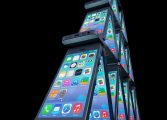Apple Logo: A Comprehensive Overview

Introduction:
The iconic Apple logo is a symbol that is instantly recognizable worldwide. It represents Apple Inc., one of the largest and most influential technology companies in the world. In this article, we will provide a thorough overview of the Apple logo, its various types, popularity, quantitative measurements, differences, and a historical analysis of its pros and cons.
1. The Apple Logo: An Overview

The Apple logo consists of a bitten apple with a leaf, usually depicted in rainbow colors. Created in 1977 by Rob Janoff, the logo has evolved over the years to its current minimalist design. Its simplicity and elegance make it instantly recognizable across a wide range of mediums, from products to advertising campaigns.
2. Types of Apple Logos and Popularity
a. The Classic Apple Logo: The rainbow-colored apple logo was the first and most well-known version. It represented Apple’s creative and innovative nature during the early years.
b. Monochromatic Apple Logo: In 1998, Apple introduced a monochromatic version of its logo, reflecting a shift towards a more minimalist design approach. This logo is widely used on all Apple products and marketing materials.
c. Apple Logo Variations: Apple occasionally releases limited edition logo variations to celebrate events or collaborations. These variations create a sense of exclusivity and collectibility among Apple enthusiasts.
3. Quantitative Measurements of the Apple Logo
a. Brand Recognition: The Apple logo consistently ranks high in various brand recognition studies. It has become synonymous with quality, innovation, and prestige.
b. Social Media Impact: The Apple logo is omnipresent on social media platforms. Hashtags such as Apple and AppleLogo generate millions of posts, illustrating its influence and popularity in the online world.
c. Global Market Penetration: The Apple logo is a significant contributor to Apple’s global market penetration. It enhances brand loyalty and drives consumer purchasing decisions.
4. Differences in Apple Logos
a. Color Variations: While the monochromatic logo is the most widely used, Apple occasionally incorporates different color schemes for product launches or special events, such as the (PRODUCT)RED campaign.
b. Size and Placement: The Apple logo’s size and placement vary across different Apple products. For example, on MacBooks, it is backlit, while on iPhones, it appears on the back.
c. Logo Adaptations: The Apple logo has undergone minor adaptations to fit different product forms, such as the Apple Watch or AirPods. These adaptations ensure consistency while catering to product-specific requirements.
5. Historical Analysis of Pros and Cons
a. Pros of the Classic Apple Logo: The rainbow-colored apple evokes nostalgia for early Apple adopters, conveying a sense of community and creativity.
b. Pros of the Monochromatic Apple Logo: The minimalistic design is timeless, modern, and versatile. It represents Apple’s focus on simplicity, elegance, and cutting-edge technology.
c. Cons of Previous Apple Logos: The rainbow-colored logo, while iconic, may have lacked the sophistication that Apple desired, leading to its redesign. Additionally, the classic logo’s intricate design made it challenging to render accurately across different mediums.
Conclusion:
The Apple logo has become an emblem of innovation, quality, and elegance in the tech industry. Its evolution from the rainbow-colored logo to the minimalist design mirrors Apple’s journey as a company. Through quantitative measurements, we can see the logo’s impact on brand recognition and its widespread influence on social media platforms. Understanding the differences and historical analysis of various Apple logos provides valuable insights into Apple’s branding strategies. The Apple logo continues to captivate individuals worldwide, making it an enduring symbol of excellence.
By delving into the depths of the Apple logo, we have explored its significance, types, popularity, quantitative measurements, differences, and historical context. This article aims to provide a thorough understanding of the Apple logo and its impact on Apple’s brand image.
















































